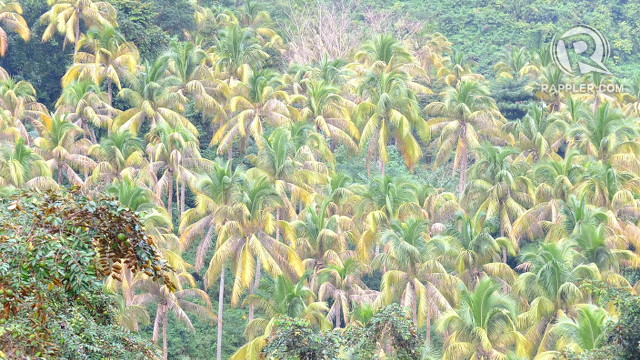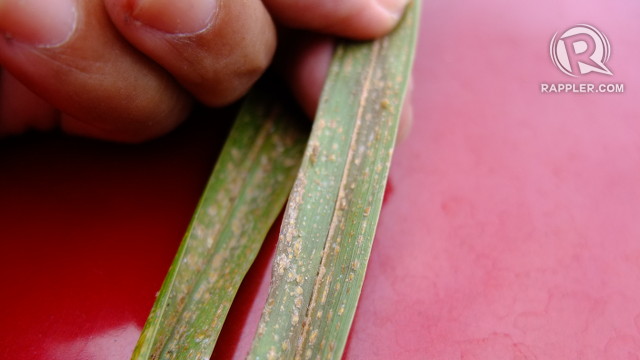SUMMARY
This is AI generated summarization, which may have errors. For context, always refer to the full article.
MANILA, Philippines – The provinces of Laguna, Cavite, Batangas and Quezon will be put under quarantine by the end of March as part of government efforts to control a pest outbreak killing more than a million coconut trees.
The quarantine means “coconuts and other products that can host the pest cannot be brought out of the areas declared under quarantine,” Philippine Coconut Authority (PCA) Administrator told Rappler in a text message.
All fruit products except for langka are affected since they can also be infested by the coconut scale insect (Aspidiotus destructor).
By the end of the month, 3 checkpoints in Bacoor, Cavite; Pagbilao, Quezon and Mabitac, Laguna will be operational, according to a PCA technical report obtained by Rappler.
Existing checkpoints in piers in the 4 provinces, such as the Batangas port, will also be in charge of monitoring the entry and exit of goods.
Last March 7, the PCA and Bureau of Plant Industry trained and deputized people to serve as quarantine checkpoint personnel. They have so far hired 18 people to man the 3 checkpoints.
The species of coconut scale insect affecting the provinces is a pest that appears as tiny yellow spores covering the underside of coconut tree leaves. They cover the leaves’ pores, blocking chlorophyl production needed to sustain the tree.
The pest causes the leaves to turn yellow, wilt and eventually fall off leaving a bald tree stump. The nuts fall prematurely. PCA scientists say the water inside the nuts taste sour. The insect reaches other trees when carried by the wind or when they come into contact with infested crops.
The species of scale insect has never been observed in the Philippines before. According to Forbes, this is why the PCA was unable to immediately contain the outbreak.
As of this February, the pest has infected a total of 1,087,983 infested trees in Laguna, Quezon, Cavite and Batangas, according to the report.
This is 20 times more than the number reported in March 2013 – around 54,000 infested trees.
The infestation was first spotted in Barangay Balele in Tanauan, Batangas. It was reported to the PCA in 2010 by which time more than 15,000 trees within a 15-kilometer radius were already infested.
By June 2011 – only 3 months after – the pest infected 11,000 more trees. By 2012, it had spread to two more provinces.
Watch coconut farmer Gilbert Negad from talk about the pests that hound coconut farms after being hit by super typhoon Yolanda (Haiyan) below.
Mysterious origins
The PCA task force is now trying to identify the origin of the mysterious insects in order to strategize how best to exterminate them.
A team of entomologists traced the insect to Manado, Indonesia where a similar outbreak was reported. They’ve brought back the species to analyze it and find new ways of stopping the spread.
The team also brought back various predator insects which may be used to kill the pests.
In the meantime, a total of 103,670 coccinellid beetles have been released in various areas all over Calabarzon. These beetles are the natural predators of scale insects.
They have been released in the following areas:
- Quezon – Sampaloc, Mauban, Dolores, Lucena, Polilio, Tiaong, Pagbilao
- Batangas – Tanauan, Laurel, Malvar, Lemery, Lipa, Talisay, Sto Tomas, San Juan
- Laguna – Cavinti, Liliw, San Pablo
The PCA is using Crop Guard, a plant-oil based substance that can increase the immunity of the trees against the pests.
They have also sprayed “effective and safe”pesticides to avert infestation of trees in high-elevation areas.
They are considering using Dinotefuran, an insecticide that disrupts the nervous system of certain insects including aphids, white grubs, beetles and cockroaches.
Infestation to worsen
A solution to the epidemic cannot come soon enough especially with summer fast approaching.
Data from the PCA shows that warm temperatures and lead to a faster spread of the infestation.
“In the hot months, the spread is faster. April, May, June, the number of infested trees is high. When December and January arrive, the spread is slower in all areas,” said agriculture scientist and coconut farmer Tony Celino.
This is why the PCA listed down global warming as a factor in the fast spread of the infestation.
Humidity is also a factor. Higher humidity during the months of June, July and August leads to higher rate of infestation.
More than 328,000 coconut farmers in Calabarzon are affected by the scale insect outbreak. Also affected are the thousands who make a living from other coconut-derived products like cooking oil, livestock feeds, ropes, blankets, vinegar, handicrafts and furniture.
The Calabarzon coconut industry is the largest in Luzon, producing more than 1.5 million coconuts in 2006. That accounts for almost half (42%) of Luzon’s total coconut production. – Rappler.com
Add a comment
How does this make you feel?


There are no comments yet. Add your comment to start the conversation.